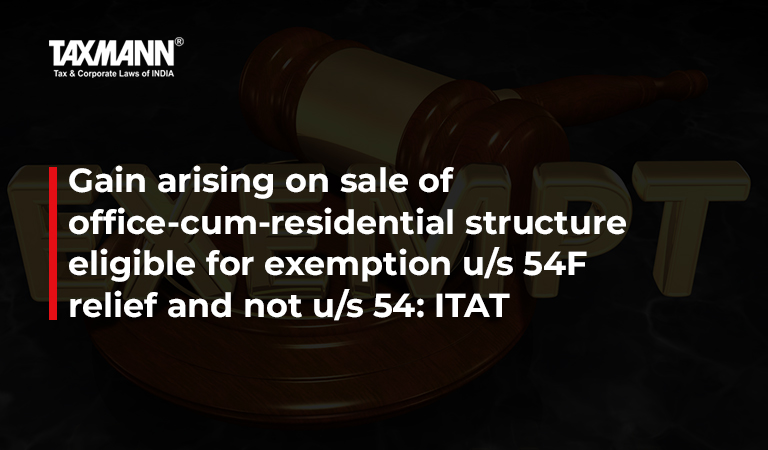Gain arising on sale of office-cum-residential structure eligible for exemption u/s 54F relief and not u/s 54: ITAT
- News|Blog|Income Tax|
- 2 Min Read
- By Taxmann
- |
- Last Updated on 24 May, 2022

Case Details: Chain Singh Mundra v. ITO - [2022] 138 taxmann.com 105 (Chandigarh-Trib.)
Judiciary and Counsel Details
-
- Smt. Diva Singh, Judicial Member & Vikram Singh Yadav, Accountant Member
- Smt. Komal Thakur, Adv. for the Appellant.
- Smt. Priyanka Dhar, Sr. DR for the Respondent.
Facts of the Case
The assessee had sold a property comprised of an industrial plot of land with an office-cum-residential structure built upon it. The assessee claimed exemption under section 54 on long-term capital gains arising on it.
The Assessing Officer (AO) denied the claim of exemption on grounds that the property sold by the assessee was an industrial plot. However, he allowed a deduction under section 54F and accordingly recomputed LTCG.
On appeal, the CIT(A) also upheld the order of AO. The aggrieved assessee filed an instant appeal to the tribunal.
ITAT Held
The Tribunal held that on perusal of the sale deed executed by the assessee, it was noticed that what has been transferred is an industrial plot along with construction thereon. Therefore, as borne out from the contents of the sale deed, it is clear that what has been transferred is an industrial plot (along with the construction thereon) and not a residential plot.
Further, on perusal of the valuation report submitted by the assessee, it was noted that the subject property was located in an industrial area with a covered area. The construction was carried out in form of the parking area, office space, residential and recreational area covering the basement, ground floor, and first floor.
The office area is built on the ground floor consisting of RCC framed structure, aluminum windows, and vitrified tile flooring. The residential area is on the first floor with a covered area having bathrooms, wooden doors, and windows.
Thus, where on an industrial plot of land, there is an office built-up area on the ground floor and a residential built-up area on the first floor, it couldn’t be said that the assessee had transferred a residential house. Accordingly, the assessee was not eligible for exemption under section 54 but it was rather eligible for exemption under section 54F.
List of Cases Reviewed
-
- Navin Jolly v. ITO [2020] 117 taxmann.com 323/272 Taxman 348/424 ITR 462 (Kar.) (para 10) distinguished.
List of Cases Referred to
-
- Navin Jolly v. ITO [2020] 117 taxmann.com 323/272 Taxman 348/424 ITR 462 (Kar.) (para 5)
Disclaimer: The content/information published on the website is only for general information of the user and shall not be construed as legal advice. While the Taxmann has exercised reasonable efforts to ensure the veracity of information/content published, Taxmann shall be under no liability in any manner whatsoever for incorrect information, if any.

Taxmann Publications has a dedicated in-house Research & Editorial Team. This team consists of a team of Chartered Accountants, Company Secretaries, and Lawyers. This team works under the guidance and supervision of editor-in-chief Mr Rakesh Bhargava.
The Research and Editorial Team is responsible for developing reliable and accurate content for the readers. The team follows the six-sigma approach to achieve the benchmark of zero error in its publications and research platforms. The team ensures that the following publication guidelines are thoroughly followed while developing the content:
- The statutory material is obtained only from the authorized and reliable sources
- All the latest developments in the judicial and legislative fields are covered
- Prepare the analytical write-ups on current, controversial, and important issues to help the readers to understand the concept and its implications
- Every content published by Taxmann is complete, accurate and lucid
- All evidence-based statements are supported with proper reference to Section, Circular No., Notification No. or citations
- The golden rules of grammar, style and consistency are thoroughly followed
- Font and size that’s easy to read and remain consistent across all imprint and digital publications are applied




